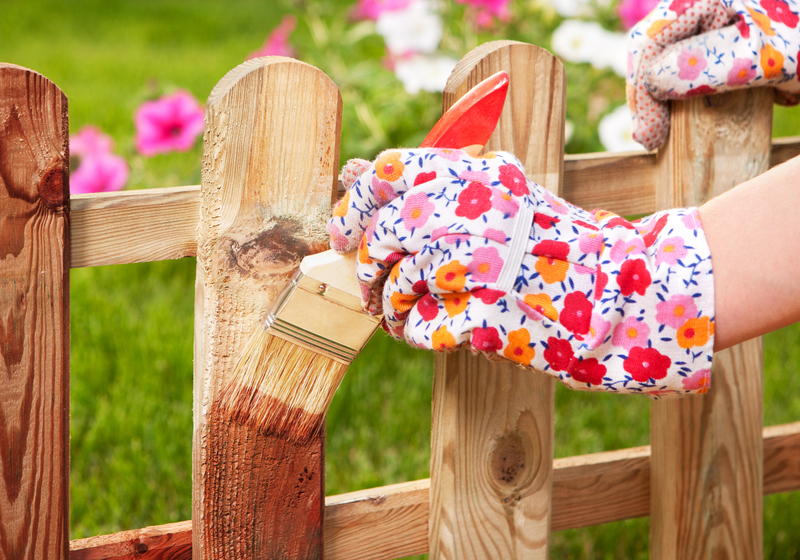Spark Imagination with a Kid-Appropriate Garden
Posted on 28/09/2025
Spark Imagination with a Kid-Appropriate Garden
Creating a kid-appropriate garden is more than just an opportunity to introduce children to the wonders of nature; it is a canvas for their imagination to bloom. Whether your goal is to foster a lifelong love of the outdoors, provide hands-on learning experiences, or simply encourage creative play, a children's garden is a magical and customizable project for the whole family.

Why Kids Need Their Own Garden Spaces
A garden for kids can be transformative, acting as both playground and classroom. Children are naturally curious, and a garden provides a safe environment for exploration and discovery. From learning about insects to understanding how plants grow, a kid-safe garden ignites curiosity, responsibility, and creativity in unique ways.
- Hands-on learning: Gardening offers practical education in science, math, and ecology.
- Sensory development: The sights, textures, and smells of a garden stimulate the senses.
- Responsibility: Caring for plants teaches children about nurturing and responsibility.
- Physical activity: Digging, planting, and watering get kids moving.
- Connection to nature: Gardens forge bonds with the natural world, reducing screen time and promoting well-being.
Key Elements of a Kid-Friendly Garden
Before you start planting, it's essential to understand what makes a garden kid-appropriate. It's not just about the plants - it's also about layout, accessibility, safety, and playfulness.
1. Safety First
- Avoid toxic plants: Choose non-toxic plants that are safe for curious hands and mouths.
- Smooth pathways: Ensure paths are level and use mulch or rubber for softer landings.
- Secure fencing: A well-fenced area keeps children safely contained and deters pests.
- Tool safety: Provide child-sized tools with ergonomic grips and store sharp implements safely.
2. Accessibility & Layout
- Raised beds: Make planting easier for little arms and less back-straining for grown-ups.
- Clear walkways: Enable safe movement and easy navigation with defined, obstacle-free paths.
- Sensory areas: Integrate sections dedicated to touch, smell, and sight - think fuzzy lamb's ear or fragrant mint.
- Seating: Create quiet nooks with benches, stumps, or hammocks for rest or reading.
3. Playful Features
- Fairy or dinosaur gardens: Miniature landscapes inspire storytelling and small-world play.
- Stepping stones & logs: Foster balance and adventure.
- Mud kitchens: Encourage messy, sensory fun with old pots, spoons, and household kitchenware.
- Hideaways: Teepees, willow tunnels, or sunflower houses become secret forts for imaginative play.
Best Plants for Sparkling Kid Gardens
A kid-appropriate garden is full of interesting, easy-growing plants. The best choices are colorful, quick to germinate, safe if touched or tasted, and engaging to the senses.
Edible Plants
- Cherry tomatoes: Sweet, bite-sized, and perfect for snacking right from the vine.
- Sugar snap peas: Easy to sow, quick to harvest, and fun to munch.
- Strawberries: Vigorous and satisfying, with juicy red fruit children love to pick.
- Lettuce and spinach: Easy greens that kids can sow, pick, and eat fresh.
- Herbs: Basil, mint, and chives add scent and taste variety.
Flowers and Sensory Plants
- Sunflowers: Magnificent, fast-growing, and visually spectacular.
- Marigolds: Bright, resilient blooms that repel pests.
- Lamb's ear: Silvery and soft, irresistible to touch.
- Nasturtiums: Edible blooms with vibrant colors and peppery taste.
- Snapdragons: Whimsical flowers that invite imaginative play.
Plants for Wildlife
- Milkweed: Supports monarch butterfly caterpillars (teach children to observe but not touch).
- Borage: Attracts bees and has edible blue flowers.
- Coneflowers and bee balm: Draw pollinators, delighting kids with bees and butterflies.
Designing a Garden to Ignite Imagination
The best imaginative gardens for children are colorful, interactive, and change with the seasons. Involve kids in every step of the process, from planning and planting to decorating and harvesting. Here are some enchanting ideas to get started:
1. Themed Mini-Gardens
- Fairy garden: Create miniature worlds with tiny houses, pebble paths, and delicate ferns.
- Dinosaur domain: Plant ferns and mosses, then add toy dinosaurs among "prehistoric" plants.
- Pizza patch: Grow tomatoes, basil, and oregano for homemade pizza nights.
2. Living Hideaways
- Sunflower house: Plant tall sunflowers and beans in a circle to form a living fort.
- Willow tunnel: Weave flexible willow branches into an arched tunnel for secret play spaces.
3. Sensory Paths
- Texture walk: Include stepping stones, grass, and mulch for varied foot sensations.
- Scented corners: Grow lavender, mint, and lemon balm at child height for irresistible sniffing.
4. Artistic Touches
- Painted stones or plant markers: Personalize the garden with handmade art.
- Wind chimes and mobiles: Fill the air with sound and movement.
- DIY garden flags: Cut and paint old fabric for cheerful, fluttering banners.
Getting Children Involved from Concept to Harvest
The heart of a kid-appropriate garden is collaboration. Children are more likely to engage with and care for a garden they helped create.
- Pick plants together: Visit a nursery and let each child select a plant for their own "plot."
- Design the layout: Give kids graph paper or garden design apps to map pathways and beds.
- Plant and sow seeds: Assign age-appropriate tasks--little ones dig holes, older kids measure spacing or label plants.
- Decorate: Let kids paint signs, pots, or rocks to add their personality to the space.
- Harvest and cook: Celebrate by making snacks from the garden, like veggie sticks, fruit salads, or herbed popcorn.
Eco-Friendly Garden Practices for Kids
One of the invaluable lessons a garden teaches is environmental stewardship. Incorporate earth-friendly practices to deepen your child's respect for the planet.
- Composting: Start a small compost bin for kitchen scraps and fallen leaves.
- Rainwater collection: Set up a kid-accessible rain barrel for watering.
- Pollinator habitats: Add bee hotels, butterfly rocks, or logs for beetles.
- Organic methods: Use mulch, hand weeding, and natural pest deterrents.
- Recycle and upcycle: Turn old containers into planters and garden art.
Gardening Projects to Keep Kids Engaged Year-Round
Part of sparking imagination is finding ways to keep interest alive through every season. Rotate activities to suit the weather and your children's changing interests.
Spring and Summer
- Start seedlings indoors in egg cartons or recycled cups.
- Plant quick-growing edibles like radishes and lettuce.
- Host garden scavenger hunts: find a purple flower, a buzzing bee, or a heart-shaped leaf.
- Water plants with homemade watering cans (punched milk jugs).
Autumn
- Collect seeds to save for next year.
- Press colorful leaves for crafts or journal pages.
- Plant bulbs for surprise blooms next spring.
- Make scarecrows using family clothes and straw.
Winter
- Grow miniature windowsill gardens with herbs or microgreens.
- Create feeders for birds using pinecones and peanut butter.
- Plan next year's garden with catalogues or drawing projects.
Tips for a Thriving and Magical Kid's Garden
- Keep it simple: Choose low-maintenance plants and layouts, keeping chores age-appropriate.
- Encourage regular visits: Make time to check on the garden daily or weekly for watering, harvesting, and play.
- Be patient: Not every plant will flourish - teach children that setbacks and surprises are part of gardening.
- Document the journey: Start a garden journal with notes, drawings, and photos.

Frequently Asked Questions about Kid-Friendly Gardens
- What is the best age to start gardening with children?
Even toddlers can help plant seeds or water. Pick simple, large-seeded plants for the youngest helpers, and add complexity as they grow. - How do I keep kids interested in gardening?
Offer a mix of instant and delayed gratification. Quick-sprouting seeds, sensory play, and imaginative features keep excitement high. - What if we don't have a yard?
Container gardening on patios, balconies, or windowsills is just as magical. Vertical wall planters, raised boxes, and hanging baskets all work well. - Are there indoor options for kid gardens?
Yes! Grow herbs, sprouts, or air plants indoors. Mini-greenhouses and hydroponic kits add another fun dimension.
Conclusion: Planting Seeds of Wonder
A kid-appropriate garden is far more than rows of vegetables or colorful blooms--it's a living laboratory that inspires imagination, empathy, and joy. By designing a garden tailored to children's needs, interests, and abilities, you give them a hands-on playground to discover nature's secrets, dream up stories, and grow lasting memories.
Ready to spark imagination and cultivate curiosity? Start planning your own magical children's garden today, and watch little hands and minds blossom alongside sunflowers, strawberries, and fairy-tale forts. The adventure--and the harvest--lasts a lifetime!

